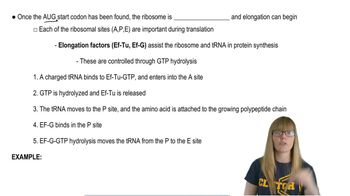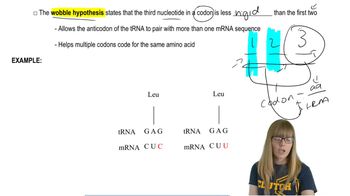Table of contents
- 1. Introduction to Genetics51m
- 2. Mendel's Laws of Inheritance3h 37m
- 3. Extensions to Mendelian Inheritance2h 41m
- 4. Genetic Mapping and Linkage2h 28m
- 5. Genetics of Bacteria and Viruses1h 21m
- 6. Chromosomal Variation1h 48m
- 7. DNA and Chromosome Structure56m
- 8. DNA Replication1h 10m
- 9. Mitosis and Meiosis1h 34m
- 10. Transcription1h 0m
- 11. Translation58m
- 12. Gene Regulation in Prokaryotes1h 19m
- 13. Gene Regulation in Eukaryotes44m
- 14. Genetic Control of Development44m
- 15. Genomes and Genomics1h 50m
- 16. Transposable Elements47m
- 17. Mutation, Repair, and Recombination1h 6m
- 18. Molecular Genetic Tools19m
- 19. Cancer Genetics29m
- 20. Quantitative Genetics1h 26m
- 21. Population Genetics50m
- 22. Evolutionary Genetics29m
11. Translation
Translation
Problem 15a
Textbook Question
The three major forms of RNA (mRNA, tRNA, and rRNA) interact during translation.
Compared to the average stability of mRNA in E. coli, is mRNA in a typical human cell more stable or less stable? Why?
 Verified step by step guidance
Verified step by step guidance1
span>1. Understand the role of mRNA in both E. coli and human cells: mRNA (messenger RNA) serves as the template for protein synthesis during translation in both prokaryotic and eukaryotic cells.</span
span>2. Consider the differences in cellular environments: E. coli is a prokaryote, while human cells are eukaryotes. This difference affects mRNA stability due to variations in cellular machinery and processes.</span
span>3. Examine the half-life of mRNA: In E. coli, mRNA typically has a short half-life, often just a few minutes, due to the rapid turnover required for quick adaptation to environmental changes.</span
span>4. Compare with human mRNA stability: In human cells, mRNA generally has a longer half-life, ranging from several hours to days, allowing for more complex regulation and sustained protein production.</span
span>5. Conclude based on stability factors: The increased stability of mRNA in human cells is due to the presence of additional regulatory elements, such as the 5' cap and poly-A tail, which protect mRNA from degradation.</span
Recommended similar problem, with video answer:
 Verified Solution
Verified SolutionThis video solution was recommended by our tutors as helpful for the problem above
Video duration:
2mPlay a video:
Was this helpful?
Key Concepts
Here are the essential concepts you must grasp in order to answer the question correctly.
Types of RNA
There are three major types of RNA involved in protein synthesis: messenger RNA (mRNA), transfer RNA (tRNA), and ribosomal RNA (rRNA). mRNA carries the genetic information from DNA to the ribosome, where proteins are synthesized. tRNA transports specific amino acids to the ribosome, matching them to the codons on the mRNA. rRNA, a structural component of ribosomes, facilitates the assembly of amino acids into proteins.
Recommended video:
mRNA Stability
mRNA stability refers to the lifespan of mRNA molecules in a cell, which affects how long they can be translated into proteins. In prokaryotes like E. coli, mRNA is typically less stable and rapidly degraded, allowing for quick responses to environmental changes. In contrast, eukaryotic cells, such as human cells, often have more stable mRNA due to additional modifications like the 5' cap and poly-A tail, which protect mRNA from degradation.
Recommended video:
Guided course

mRNA Processing
Translation Process
Translation is the process by which ribosomes synthesize proteins using the information encoded in mRNA. This process involves the coordinated action of mRNA, tRNA, and rRNA. The stability of mRNA influences the efficiency and duration of translation; more stable mRNA can lead to increased protein production, while less stable mRNA may result in lower protein levels due to rapid degradation.
Recommended video:
Guided course

mRNA Processing

 7:58m
7:58mWatch next
Master Translation initiation with a bite sized video explanation from Kylia Goodner
Start learning





